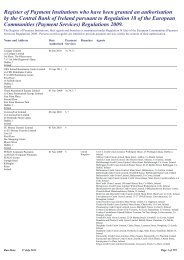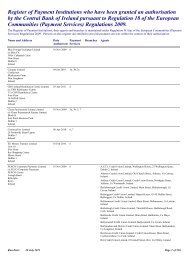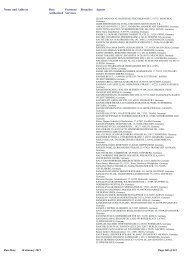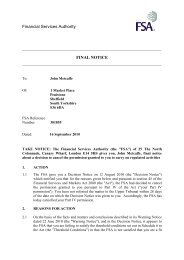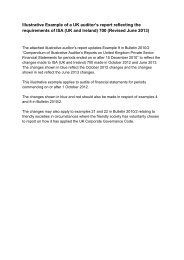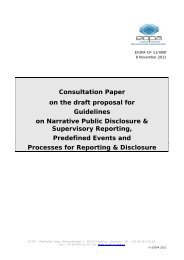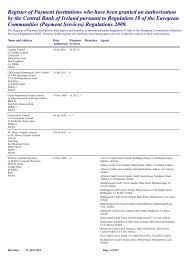Twin-peaks regulation: key changes and ... - Better Regulation
Twin-peaks regulation: key changes and ... - Better Regulation
Twin-peaks regulation: key changes and ... - Better Regulation
You also want an ePaper? Increase the reach of your titles
YUMPU automatically turns print PDFs into web optimized ePapers that Google loves.
financial services<br />
<strong>Twin</strong>-<strong>peaks</strong><br />
<strong>regulation</strong>:<br />
<strong>key</strong> <strong>changes</strong> <strong>and</strong><br />
challenges<br />
november 2012<br />
kpmg.co.uk/fs
<strong>Twin</strong> <strong>peaks</strong>:<br />
the new l<strong>and</strong>scape<br />
On 15 <strong>and</strong> 16 October 2012, the fsa released publications outlining the approach to be taken by two new bodies, the<br />
Prudential <strong>regulation</strong> authority (Pra) <strong>and</strong> the financial conduct authority (fca), in regulating the UK fnancial services<br />
industry. The introduction of a ‘twin <strong>peaks</strong>’ model is a major milestone for the regulatory reform Programme <strong>and</strong> is the<br />
frst step in changing the UK regulatory structure in 2013.<br />
The new model will mean that deposit takers, insurers <strong>and</strong> major investment frms will have two groups of supervisors,<br />
one focusing on prudential (the Pra) <strong>and</strong> one focusing on conduct (the fca). all other frms (i.e. those not ‘dual regulated’)<br />
will be solely supervised by fca. structurally, the new system looks like this:<br />
Producing <strong>and</strong> enhancing the stability of the fnancial<br />
services system of the United Kingdom, aiming to work<br />
with other relevant bodies including the Treasury, the<br />
PRA <strong>and</strong> the FCA. The Bank’s Special Resolution Unit is<br />
responsible for resolving failing banks using the Specifc<br />
resolution regime<br />
Prudential<br />
<strong>regulation</strong><br />
Systemic infrastructure<br />
Central counterparties, settlement<br />
Systems <strong>and</strong> payment systems<br />
Bank of Engl<strong>and</strong><br />
PRA<br />
Enhancing fnancial stability by promoting<br />
the safety <strong>and</strong> soundness of PRA<br />
authorised persons, including minimising<br />
the impact of their failure<br />
Prudential<br />
<strong>regulation</strong><br />
Source: HM Treasury, A new approach to fnancial <strong>regulation</strong>: building a stronger system, 2011<br />
The fPc will have responsibility for reducing risks to the<br />
fnancial system as a whole. The Pra is likely to follow direction<br />
from the fPc based on its view of the macroprudential<br />
environment <strong>and</strong> sectoral intelligence when taking frm-specifc<br />
decisions, deploying prudential regulatory tools or developing<br />
policy. firms will be able to review the fPc’s periodic financial<br />
stability report to underst<strong>and</strong> the recommendations that the<br />
committee is making to the Pra <strong>and</strong> assess the likely direction<br />
of future macro-prudential <strong>regulation</strong>.<br />
exact numbers have yet to be determined, but around 25,000<br />
frms will be solely regulated by the fca <strong>and</strong> around 2,000<br />
will be dual regulated. To underst<strong>and</strong> what prompted the<br />
split into the Pra <strong>and</strong> fca, we need only look at the mission<br />
FPC<br />
Contribution to the Bank’s objective to protect <strong>and</strong><br />
enhance fnancial stability, through identifying <strong>and</strong><br />
taking action to remove or reduce systemic risks,<br />
with a view to protecting <strong>and</strong> enhancing the<br />
resilience of the UK fnancial system<br />
FPC powers of recommendation <strong>and</strong> direction<br />
to address systemic risk<br />
Prudentially signifcant frms,<br />
Deposit takers, insurance,<br />
some Investment frms<br />
FCA<br />
Enhancing confdence in the UK fnancial system by facilitating<br />
effciency <strong>and</strong> choice in services, securing an appropriate<br />
degree of protection, <strong>and</strong> protecting <strong>and</strong> enhancing the<br />
integrity of the UK fnancial system<br />
Conduct<br />
<strong>regulation</strong><br />
Prudential <strong>and</strong><br />
conduct <strong>regulation</strong><br />
Investment frms <strong>and</strong> ex<strong>changes</strong>,<br />
other fnancial services providers including<br />
IFAs, investment ex<strong>changes</strong>, insurance<br />
brokers <strong>and</strong> fund managers<br />
statements of these bodies. The fca’s vision is “to make<br />
fnancial markets work well so consumers get a fair deal”<br />
<strong>and</strong> the Pra’s sole objective is “to promote the safety <strong>and</strong><br />
soundness of Pra authorised frms”.<br />
The fca’s focus, therefore, is on ensuring that services <strong>and</strong><br />
products are designed to meet customers’ needs <strong>and</strong> that<br />
frms put the interests of customers at the heart of how they<br />
run their business. The creation of the Pra is an attempt to<br />
focus more closely on ensuring that frms are more resilient<br />
against failure, <strong>and</strong> minimising the impact that a frm’s failure<br />
has on the UK fnancial system, while accepting that a zero<br />
failure regime is not a feasible proposition.<br />
© 2012 KPMG llP, a UK limited liability partnership, is a subsidiary of KPMG europe llP <strong>and</strong><br />
a member frm of the KPMG network of independent member frms affliated with KPMG<br />
2 | <strong>Twin</strong>-<strong>peaks</strong> <strong>regulation</strong>: <strong>key</strong> <strong>changes</strong> <strong>and</strong> challenges international cooperative, a swiss entity. all rights reserved. Printed in the United Kingdom.
There are big <strong>changes</strong> in what<br />
we are doing, <strong>and</strong> it is an<br />
exciting time to be putting<br />
these <strong>changes</strong> into effect.We<br />
will get a much clearer focus<br />
from splitting prudential <strong>and</strong><br />
conduct <strong>regulation</strong> for banks <strong>and</strong><br />
insurers, from introducing macroprudential<br />
<strong>regulation</strong> to help<br />
to protect the fnancial system<br />
as a whole, <strong>and</strong> from focusing<br />
our <strong>regulation</strong> on applying<br />
judgement in a transparent way.<br />
Andrew Bailey, Deputy CEO designate of<br />
the PRA (October 2012)<br />
© 2012 KPMG llP, a UK limited liability partnership, is a subsidiary of KPMG europe llP <strong>and</strong><br />
a member frm of the KPMG network of independent member frms affliated with KPMG<br />
international cooperative, a swiss entity. all rights reserved. Printed in the United Kingdom.<br />
<strong>Twin</strong>-<strong>peaks</strong> win-<strong>peaks</strong> <strong>regulation</strong>: k<strong>key</strong><br />
y c<strong>changes</strong><br />
hanges <strong>and</strong> cchallenges<br />
hallenges | 3
New Powers<br />
although the Pra will take a more forward-looking, judgement-based approach to prudential supervision, its powers will not<br />
change signifcantly from those that have been granted to the fsa.<br />
The new fca, however, has been granted new powers with which to supervise <strong>and</strong> enforce compliance with regulatory<br />
requirements. The fca’s new powers will include the following:<br />
Area of focus New powers<br />
Product governance<br />
<strong>and</strong> intervention<br />
The FCA are not proposing that they should pre-approve new products, but have signifcantly increased powers in the<br />
area of product governance – the design, operation <strong>and</strong> sale of products. They will intervene early in a product’s life<br />
span <strong>and</strong> have the power to ban products that they consider pose unacceptable risks.<br />
Financial promotions The FCA can direct frms to withdraw or amend misleading fnancial promotions with immediate effect <strong>and</strong> publish the<br />
fact that a warning notice relating to a disciplinary matter has been issued.<br />
Super-complaints Certain consumer organisations will be able to make ‘super-complaints’ relating to issues that affect large groups<br />
of customers.<br />
Consumer credit The Government will make its fnal decision on whether to transfer responsibility for consumer credit <strong>regulation</strong> from<br />
the OFT to the FCA during 2013. Around half of frms with credit licenses are estimated to be at present unregulated<br />
by the FSA. The other half could face additional regulatory requirements from 2014 if the transfer goes ahead.<br />
Competition This is another area where the FCA’s approach is embryonic, but there will be a focus on promoting better services,<br />
choice <strong>and</strong> value for customers, <strong>and</strong> the FCA will distinguish between innovation that benefts rather than exploits<br />
customers. Examples of past competition failures include commission payments that incentivise advisors to favour<br />
recommending sub-optimal products, or a sales process that encourages customers to take out PPI without<br />
shopping around.<br />
© 2012 KPMG llP, a UK limited liability partnership, is a subsidiary of KPMG europe llP <strong>and</strong><br />
a member frm of the KPMG network of independent member frms affliated with KPMG<br />
4 | <strong>Twin</strong>-<strong>peaks</strong> <strong>regulation</strong>: <strong>key</strong> <strong>changes</strong> <strong>and</strong> challenges international cooperative, a swiss entity. all rights reserved. Printed in the United Kingdom.
[<strong>Twin</strong> <strong>peaks</strong>] will embed the forwardlooking,<br />
judgement-based approach<br />
<strong>and</strong> accelerate the move away from<br />
the old reactive style of <strong>regulation</strong>.The<br />
<strong>changes</strong> will not just be structural but<br />
involve behavioural shifts from both<br />
supervisors <strong>and</strong> frms.<br />
Hector Sants, FSA Chief Executive (March 2012)<br />
What challenges do these new powers<br />
create for your frm?<br />
• Products will need to be tested before launch to<br />
ensure that they deliver to customer expectations<br />
• all products should be regularly monitored using a<br />
holistic range of MI to ensure they remain suitable<br />
<strong>and</strong> consistently deliver good customer outcomes<br />
• You will need to have robust controls to ensure that<br />
promotions are compliant yet commercially<br />
effective <strong>and</strong> are in line with the expectations of the<br />
fca <strong>and</strong> the approach of peer frms. staff responsible<br />
for approving promotions must have the right<br />
capabilities <strong>and</strong> competence to ensure promotions<br />
are compliant<br />
• The regulator has given little guidance on new media<br />
but frms will need to be proactive in ensuring that<br />
communications made via new media, such as Twitter<br />
or facebook, are compliant<br />
• firms should conduct product risk assessments to<br />
ensure that existing products will not be seen as taking<br />
advantage of customers, <strong>and</strong> can be demonstrated to<br />
provide value <strong>and</strong> beneft<br />
• You should be able to show that your end-to-end sales<br />
process is not only compliant with the letter of the<br />
rules, but is also designed <strong>and</strong> operated in a way which<br />
minimises the risk of customer detriment through<br />
appropriate controls against inappropriate behaviours<br />
© 2012 KPMG llP, a UK limited liability partnership, is a subsidiary of KPMG europe llP <strong>and</strong><br />
a member frm of the KPMG network of independent member frms affliated with KPMG<br />
international cooperative, a swiss entity. all rights reserved. Printed in the United Kingdom. <strong>Twin</strong>-<strong>peaks</strong> <strong>regulation</strong>: <strong>key</strong> <strong>changes</strong> <strong>and</strong> challenges | 5
Changes to the supervisory<br />
framework: PRA<br />
The Pra will focus on the ‘big picture’ <strong>and</strong> on underst<strong>and</strong>ing where the main risks to the stability of the fnancial system lie, <strong>and</strong><br />
so the test of materiality for points raised with you will be high.<br />
The Pra will be forward-looking, seeking to assess whether, on the balance of risks, there are vulnerabilities in frms’ business<br />
models, capital <strong>and</strong> liquidity positions, governance, risk management <strong>and</strong> controls that cast into doubt a frm’s future fnancial<br />
soundness. risks to the stability of the fnancial system will be assessed via a fve step risk assessment framework:<br />
PRA - Risk Assessment Framework<br />
Gross risk Safety <strong>and</strong> soundness<br />
Potential impact Risk context<br />
Potential impact<br />
Assessment will be directly<br />
through the impact of frm<br />
failure on real economic<br />
activity or the soundness<br />
of other intermediaries <strong>and</strong><br />
through behavioural effects<br />
where vulnerabilities within<br />
one frm affect confdence<br />
in others.<br />
External<br />
context<br />
Business<br />
risks<br />
The PRA will consider<br />
whether <strong>and</strong> how the wider<br />
external macroeconomic <strong>and</strong><br />
business complexity affect<br />
the execution of a frm’s<br />
business model in a variety<br />
of different scenarios.<br />
System-wide risks (interest<br />
rates, excess credit growth)<br />
<strong>and</strong> sectoral risks<br />
(e.g. Credit concentrations)<br />
will be assessed.<br />
Operational<br />
mitigation<br />
Risk<br />
management<br />
<strong>and</strong> controls<br />
Management<br />
<strong>and</strong><br />
governance<br />
The PRA will evaluate<br />
the quality of a frm’s<br />
risk management <strong>and</strong><br />
governance. This will<br />
include an assessment of<br />
the adequacy <strong>and</strong> integrity<br />
of its risk management,<br />
systems <strong>and</strong> controls,<br />
culture, governance <strong>and</strong><br />
the competence of its<br />
senior management.<br />
Financial<br />
mitigation<br />
Structural<br />
mitigation<br />
Liquidity Capital Potential impact<br />
The PRA will consider a frm’s<br />
fnancial strength. This will<br />
include an assessment of<br />
the level of capital a frm is<br />
holding against uncertainties<br />
about the valuation of assets<br />
<strong>and</strong> future risks; as well<br />
as the quality of its funding<br />
<strong>and</strong> liquid assets <strong>and</strong><br />
its approach to liquidity<br />
management, including<br />
contingency planning.<br />
If a frm can be resolved<br />
in an orderly manner,<br />
the overall risk that it<br />
poses to the stability of<br />
the fnancial system will<br />
be lessened. Working<br />
with the Bank’s Special<br />
Resolution Unit <strong>and</strong><br />
the FSCS, the PRA will<br />
consider whether, <strong>and</strong><br />
with what impact a frm<br />
could be resolved.<br />
• All frms will be subject to baseline supervisory monitoring, comprising an (at least) annual review of a frm’s resolvability, an assessment of the principal risks to<br />
fnancial stability, an analysis of a frm’s fnancial position, discussions with senior management at the frm <strong>and</strong> compliance with minimum prudential st<strong>and</strong>ards for<br />
capital, liquidity <strong>and</strong> large exposures.<br />
• Those frms that present the greatest risk to the stability of the fnancial system will be subject to more focus from the PRA.<br />
• The PRA will also establish a Proactive Intervention Framework (PIF) which is intended, as part of the ongoing process of supervision, to identify early risks to a frm’s<br />
viability <strong>and</strong> ensure that frms take appropriate remedial action. It will fag actions that the authorities will need to take in advance to prepare for the failure <strong>and</strong><br />
resolution of a frm.<br />
What challenges does this new approach<br />
create for your frm?<br />
• There must be a visible focus from the leadership team on<br />
risk management which manifests through documented<br />
risk-based decision-making<br />
• Stress <strong>and</strong> scenario testing, including reverse stress<br />
testing, will be seen as a <strong>key</strong> tool for management in<br />
assessing the sustainability of the business model<br />
• Your frm’s leadership team will need to demonstrate<br />
a good underst<strong>and</strong>ing of the approach that you use to<br />
assess your frm’s capital <strong>and</strong> liquidity adequacy<br />
• You will need to evidence that your frm’s overall<br />
governance arrangements, including Board effectiveness<br />
<strong>and</strong> oversight, are designed appropriately <strong>and</strong> operated<br />
effectively. robust governance should extend throughout<br />
the business to the front-line<br />
• Your Management Information must be suitably detailed<br />
<strong>and</strong> robust to highlight <strong>key</strong> risk exposures<br />
• There should be clarity of risk ownership with clear<br />
delineation of responsibility between the business <strong>and</strong> the<br />
risk function<br />
• Your frm’s risk concentrations <strong>and</strong> aggregations must<br />
be visible <strong>and</strong> it should be readily apparent how these are<br />
being managed<br />
© 2012 KPMG llP, a UK limited liability partnership, is a subsidiary of KPMG europe llP <strong>and</strong><br />
a member frm of the KPMG network of independent member frms affliated with KPMG<br />
6 | <strong>Twin</strong>-<strong>peaks</strong> <strong>regulation</strong>: <strong>key</strong> <strong>changes</strong> <strong>and</strong> challenges international cooperative, a swiss entity. all rights reserved. Printed in the United Kingdom.
Changes to the supervisory<br />
framework: FCA<br />
Perhaps the most signifcant effect that frms will feel is in<br />
the area of supervision. The new approach to supervision<br />
demonstrates that the fca’s focus has changed from<br />
assessing technical compliance to quantifying major<br />
business risks. To achieve this aim, supervision will be more<br />
judgement-based, starting at the frm’s business model <strong>and</strong><br />
strategy <strong>and</strong> leading to early intervention on the basis of<br />
assessment of conduct risk rather than crystallised issues.<br />
The frst stage will involve re-categorising frms (a process<br />
which has yet to be fnalised) according to the risks they pose<br />
to customers <strong>and</strong> the market, which will impact the approach<br />
to supervision as follows:<br />
Category Criteria Approach to supervision<br />
C1 Banking <strong>and</strong> insurance groups with very large numbers of<br />
retail customers<br />
Universal/investment banks with very large client assets<br />
C2 Firms with a substantial number of retail customers <strong>and</strong>/or<br />
large wholesale frms<br />
C3<br />
Firms with retail customers <strong>and</strong>/or a signifcant<br />
wholesale presence<br />
• Dedicated supervisor<br />
• Firm-by-frm business model <strong>and</strong> strategy analysis<br />
• Dedicated supervisor<br />
• Firms grouped within sectors to identify common risks of<br />
business models <strong>and</strong> strategy<br />
• Supervised by a team of sector specialists<br />
• Sampling of frms’ business models <strong>and</strong> strategies<br />
C4 Smaller frms, most intermediaries • Supervised by a team of sector specialists<br />
© 2012 KPMG llP, a UK limited liability partnership, is a subsidiary of KPMG europe llP <strong>and</strong><br />
a member frm of the KPMG network of independent member frms affliated with KPMG<br />
international cooperative, a swiss entity. all rights reserved. Printed in the United Kingdom. <strong>Twin</strong>-<strong>peaks</strong> <strong>regulation</strong>: <strong>key</strong> <strong>changes</strong> <strong>and</strong> challenges | 7
Changes to the supervisory<br />
framework: FCA (continued)<br />
There are 3 main tools which will be used in supervising frms, with a much greater emphasis on identifying <strong>and</strong> mitigating<br />
potential customer detriment before it occurs:<br />
1. Firm Systematic Framework (FSF)<br />
The FSF replaces ARROW with an approach that features the following areas of focus, to answer some <strong>key</strong> questions:<br />
Area of focus How is this different? Key questions the FCA will ask<br />
Business model <strong>and</strong><br />
strategy analysis<br />
(BMSA)<br />
Four supervisory<br />
modules:<br />
i. Governance <strong>and</strong> culture<br />
ii. Product design<br />
iii.Sales or transaction<br />
processes<br />
iv. Post-sales/services <strong>and</strong><br />
transaction h<strong>and</strong>ling<br />
This is an assessment of the root cause of conduct risk<br />
rather than the issues-based approach of ARROW.<br />
For C1 <strong>and</strong> C2 frms, these modules will be assessed on<br />
an going basis, rather than the point-in-time approach<br />
of ARROW.<br />
The output of the FSF will be a focussed set of actions,<br />
rather than the long RMP under ARROW.<br />
Follow up work will be pushed onto the frm, using s166<br />
powers where necessary, rather than being completed by<br />
the regulator.<br />
• Is the business sustainable from a conduct perspective?<br />
• What are the future conduct risks?<br />
• What do the margins on products tell us <strong>and</strong> where are<br />
the growth areas?<br />
• How effectively is the frm identifying, managing <strong>and</strong><br />
mitigating conduct risks?<br />
• Are products targeted at customer needs?<br />
• Do the frm’s processes support appropriate<br />
customer outcomes?<br />
• Is the fair treatment of customers considered after the<br />
point of sale?<br />
• Is Senior Management taking individual responsibility<br />
for the right areas?<br />
Note, in the remaining lifetime of the FSA the current ARROW cycle will be retained. So if your frm is due to complete an ARROW assessment before Spring 2013 it will still be subject to a supervisory review,<br />
however that review will consist of 2 supervisory teams assessing the risks against their new objectives.<br />
2. Event-driven work<br />
Using a greater pool of fexible resources, the FCA will continue to react<br />
to crystallised issues, identifed through, for example, complaints data,<br />
whistle blowers or more innovative use of intelligence derived from new<br />
media, for example.<br />
This intelligence-led approach is aligned with the desire by the FCA to<br />
take quicker <strong>and</strong> more decisive action to correct regulatory failures.<br />
3. Issues <strong>and</strong> products<br />
Driven by sector risk assessment (SRA), this work will look at <strong>key</strong> product<br />
issues, emerging risks <strong>and</strong> frm specifc risks. FCA action may take the<br />
form of policy, enforcement or efforts to promote competition, alongside<br />
or in place of more traditional supervisory responses.<br />
The FCA is clear that there will be a focus on wholesale as well as retail<br />
conduct supervision. While accepting that different customers have<br />
different experience <strong>and</strong> expertise, no categories of customers will avoid<br />
the scope of supervision. As we have seen with Interest Rates Hedging<br />
Products, which are originated in investment banks but are ultimately<br />
also sold to retail customers, these products are likely to come under<br />
greater regulatory scrutiny.<br />
© 2012 KPMG llP, a UK limited liability partnership, is a subsidiary of KPMG europe llP <strong>and</strong><br />
a member frm of the KPMG network of independent member frms affliated with KPMG<br />
8 | <strong>Twin</strong>-<strong>peaks</strong> <strong>regulation</strong>: <strong>key</strong> <strong>changes</strong> <strong>and</strong> challenges international cooperative, a swiss entity. all rights reserved. Printed in the United Kingdom.
What challenges do these <strong>changes</strong> create<br />
for your frm?<br />
Business Model <strong>and</strong> Strategy Analysis<br />
• You will need to have conducted BMsa, which analyses<br />
your frm’s market position through the lens of conduct<br />
risk. This should establish your conduct risk appetite <strong>and</strong><br />
ensure it is aligned to your strategy, critically analyse your<br />
current <strong>and</strong> future strategy (including competitor analysis<br />
<strong>and</strong> considering the effect on consumers), identify the<br />
<strong>key</strong> drivers of conduct risk, highlight priority areas <strong>and</strong><br />
incorporate an action plan to mitigate conduct risk<br />
Governance <strong>and</strong> culture<br />
• Your governance structures should be operating effectively,<br />
aligned to a customer-focussed culture<br />
• Your risk <strong>and</strong> compliance functions must be effective in<br />
meeting new regulatory challenges. This means a move<br />
away from monitoring technical compliance <strong>and</strong> adopting a<br />
forward-looking, judgement-based approach based on<br />
an assessment of risk. adopting a conduct risk approach<br />
will help defne the role <strong>and</strong> priorities of risk <strong>and</strong> compliance<br />
• senior Management must underst<strong>and</strong> the new supervisory<br />
approach <strong>and</strong> you should be ready for your frst FCA visit<br />
– there will be more personal, individual accountability for<br />
<strong>key</strong> elements of regulatory focus<br />
Product design<br />
• Product design drivers should be based on clear customer<br />
need evidenced through data or research. Design should<br />
follow from customer insight <strong>and</strong> focus on meeting customer<br />
expectations as well as achieving commercial targets<br />
© 2012 KPMG llP, a UK limited liability partnership, is a subsidiary of KPMG europe llP <strong>and</strong><br />
a member frm of the KPMG network of independent member frms affliated with KPMG<br />
international cooperative, a swiss entity. all rights reserved. Printed in the United Kingdom.<br />
• Products should go through a clear ‘gateway’ approval<br />
<strong>and</strong> sign off process which includes compliance, legal<br />
<strong>and</strong> consumer champion stakeholders which tests the<br />
customer value in new products. clear parameters need<br />
to be set where more ‘light touch’ sign offs can be applied<br />
(e.g. little change in product features)<br />
Sales or transaction processes<br />
• sales are fair <strong>and</strong> clearly describe the product, ancillary<br />
options <strong>and</strong> pricing structures in order that customers are<br />
able to make an informed choice as to the benefts <strong>and</strong><br />
suitability of the product<br />
• Where advice is given, it must be demonstrably suitable<br />
<strong>and</strong> take into consideration the hierarchy of customer needs<br />
Post-sales/services <strong>and</strong> transaction h<strong>and</strong>ling<br />
• customers’ expectations are met <strong>and</strong> customers<br />
consistently obtain appropriate <strong>and</strong> fair outcomes<br />
after the point of sale (including complaints, customer<br />
communications <strong>and</strong> ongoing charges)<br />
• Outcome testing should be conducted on a regular basis.<br />
Where customers are not obtaining consistently fair<br />
outcomes or where products fail to meet their reasonable<br />
expectations, the design of the product needs to be<br />
re-reviewed <strong>and</strong> amended appropriately – in addition to<br />
any relevant remediation required.<br />
<strong>Twin</strong>-<strong>peaks</strong> <strong>regulation</strong>: <strong>key</strong> <strong>changes</strong> <strong>and</strong> challenges | 9
Changes to enforcement<br />
FCA Enforcement <strong>changes</strong><br />
In terms of Enforcement, the FCA is committed to progressing the<br />
direction in which we have already seen the FSA moving. This means<br />
that we can expect to see:<br />
• More enforcement cases, including the use of s166 powers<br />
• More severe penalties, including higher fnes<br />
• An increased focus on action against individuals, especially<br />
senior management<br />
• More criminal prosecutions for offences such as insider trading<br />
• A focus on pursuing compensation for customers.<br />
In addition, the FCA will have the power to publicise the fact that it is<br />
taking enforcement action against a frm or individual.<br />
10 | <strong>Twin</strong>-<strong>peaks</strong> win-<strong>peaks</strong> <strong>regulation</strong>: k<strong>key</strong><br />
y c<strong>changes</strong><br />
hanges <strong>and</strong> cchallenges<br />
hallenges<br />
What challenges do these <strong>changes</strong> create<br />
for your frm?<br />
• When problems occur you need to identify them quickly,<br />
remediate them effectively <strong>and</strong> learn from them<br />
• You will need to demonstrate that <strong>key</strong> aspects of your<br />
business model or culture, such as remuneration <strong>and</strong><br />
incentivisation, product development <strong>and</strong> training <strong>and</strong><br />
recruitment are designed <strong>and</strong> operated in a way which<br />
takes into account the needs of customers<br />
• The compliance function needs to have a prominent <strong>and</strong><br />
defned role in <strong>key</strong> aspects of the business, including<br />
product development <strong>and</strong> overseeing customer interaction<br />
to ensure that good customer outcomes are achieved<br />
• You must be able to evidence the “tone from the top”<br />
needed to demonstrate a customer-focussed culture<br />
• Your frm’s systems <strong>and</strong> controls must mitigate the risk<br />
of fnancial crime (fraud, money laundering <strong>and</strong> bribery<br />
<strong>and</strong> corruption)<br />
The FCA’s core<br />
purpose is to make<br />
sure markets work<br />
well so consumers get<br />
a fair deal – to do that<br />
we will have not only<br />
new powers, but a new<br />
supervisory approach <strong>and</strong><br />
a new culture. Key to the<br />
success of this approach is<br />
ensuring that good consumer<br />
outcomes are built into the<br />
business models of the frms<br />
we regulate.<br />
Martin Wheatley, CEO designate of the<br />
FCA (July 2012)<br />
© 2012 KPMG llP, a UK limited liability partnership, is a subsidiary of KPMG europe llP <strong>and</strong><br />
a member frm of the KPMG network of independent member frms affliated with KPMG<br />
international cooperative, a swiss entity. all rights reserved. Printed in the United Kingdom.
Summary of <strong>key</strong> <strong>changes</strong><br />
We set out below the new Pra <strong>and</strong> fra regulatory frameworks. as you will see, these combine new elements <strong>and</strong> existing<br />
tools in a way that represents a new model <strong>and</strong> approach to <strong>regulation</strong>.<br />
The PRA’s new framework<br />
Risk <strong>and</strong> impact<br />
identifcation<br />
• Forward looking, judgment based<br />
<strong>and</strong> commensurate with the level<br />
of risk<br />
• Risk assessment based on the<br />
extent to which the business<br />
model is sustainable<br />
• Risk alerts:<br />
- Annual review of resolution plans<br />
- Assessment of compliance<br />
with capital, liquidity <strong>and</strong> large<br />
exposure st<strong>and</strong>ards<br />
- Regular contact with senior<br />
management<br />
• Challenging but constructive<br />
relationships<br />
• Focus on impact that frm failure<br />
would have on fnancial stability<br />
without relying solely on the<br />
resolution regime<br />
The FCA’s new framework<br />
Risk <strong>and</strong> impact<br />
identifcation<br />
PRA intervention<br />
• Policies <strong>and</strong> rules on frms’<br />
resilience (covering such areas<br />
as capital, liquidity <strong>and</strong> leverage)<br />
• Supervisory assessments <strong>and</strong><br />
interventions<br />
• Mechanisms to support resolution<br />
• Early <strong>and</strong> proactive supervisory<br />
interventions designed to reduce<br />
risks to the stability of the system<br />
FCA intervention<br />
Risk mitigation/<br />
remediation<br />
• S166 reports<br />
• Pillar II Capital add-ons<br />
• Use of statutory powers to compel<br />
frms to take actions<br />
• Restrictions on permissions<br />
• Fine frms/individuals<br />
• Prosecution through the courts<br />
• Disclosure <strong>and</strong> market discipline<br />
Risk mitigation/<br />
remediation<br />
Review<br />
• Self reporting by frms<br />
• Third party reviews<br />
• Follow up supervision visits<br />
Review<br />
• Conduct risk <strong>and</strong> market analysis • Whole market/sector wide review • Competition referral • Self reporting by frms<br />
• Business model analysis • Firm/peer group review • Market-wide policy interventions • Increased use of third party reviews<br />
• Risk alerts: • Product/thematic interventions • Individual frm risk mitigation plans • Follow up supervision visits but<br />
- Product sales data • Governance/risk • S166 Reports these are no longer the primary tool<br />
- Regulatory returns/ framework effectiveness • Product level prohibition<br />
complaints data • Consumer redress programmes<br />
- Market intelligence • Tougher enforcement action<br />
• Conduct supervision activity<br />
• Referral by consumer groups<br />
(‘super complaints’)<br />
Where are the opportunities?<br />
The <strong>changes</strong> outlined here represent an opportunity to take<br />
control of <strong>and</strong> manage regulatory risk, by reacting quickly<br />
<strong>and</strong> effectively to the changing approach to supervision, to<br />
seize a competitive advantage. Consider the following...<br />
• supervisors are more empowered to make judgements,<br />
based in part on the information you provide them. so take<br />
the opportunity to get it right - ensure your Mi allows them<br />
to make what you feel are the right judgements<br />
• More pro-active <strong>regulation</strong>, looking to prevent issues rather<br />
than focus on remediation of crystallised issues, means<br />
© 2012 KPMG llP, a UK limited liability partnership, is a subsidiary of KPMG europe llP <strong>and</strong><br />
a member frm of the KPMG network of independent member frms affliated with KPMG<br />
international cooperative, a swiss entity. all rights reserved. Printed in the United Kingdom.<br />
that there is value in showing that you underst<strong>and</strong> the root<br />
cause of conduct issues...’not just deal with symptoms at<br />
the point where the failure occurs across the value chain’.<br />
consider PPi as an example<br />
• The Pra will focus on the ‘big picture’ <strong>and</strong> on underst<strong>and</strong>ing<br />
where the main risks to the stability of the fnancial system<br />
lie, so getting it right will reduce the supervisory burden on<br />
the frm<br />
• The fca will focus on the product lifecycle, including the<br />
power to ban products, so investing in robust approval<br />
processes <strong>and</strong> monitoring over the lifecycle will signifcantly<br />
reduce regulatory risk<br />
<strong>Twin</strong>-<strong>peaks</strong> <strong>regulation</strong>: <strong>key</strong> <strong>changes</strong> <strong>and</strong> challenges | 11
Contact us<br />
Fiona Fry<br />
Partner<br />
financial services<br />
frM regulatory<br />
T: +44 (0) 20 7694 2364<br />
E: fona.fry@kpmg.co.uk<br />
Giles Williams<br />
Partner<br />
regulatory centre of excellence<br />
eMa region<br />
T: +44 (0) 20 7311 5354<br />
E: giles.williams@kpmg.co.uk<br />
Nicholas Henderson<br />
Partner<br />
financial services<br />
frM regulatory<br />
T: +44 (0) 20 7694 2172<br />
E: nicholas.henderson@kpmg.co.uk<br />
Giles Adams<br />
Partner<br />
financial services<br />
frM regulatory<br />
T: +44 (0) 20 7694 2143<br />
E: giles.adams@kpmg.co.uk<br />
Tim Howarth<br />
Partner<br />
financial services<br />
frM regulatory<br />
T: +44 (0) 20 7311 6640<br />
E: tim.howarth@kpmg.co.uk<br />
www.kpmg.co.uk<br />
The information contained herein is of a general nature <strong>and</strong> is not intended to address the circumstances of any particular<br />
individual or entity. Although we endeavour to provide accurate <strong>and</strong> timely information, there can be no guarantee that such<br />
information is accurate as of the date it is received or that it will continue to be accurate in the future. No one should act on such<br />
information without appropriate professional advice after a thorough examination of the particular situation.<br />
© 2012 KPMG LLP, a UK limited liability partnership, is a subsidiary of KPMG Europe LLP <strong>and</strong> a member frm of the KPMG network<br />
of independent member frms affliated with KPMG International Cooperative, a Swiss entity. All rights reserved.<br />
Printed in the United Kingdom.<br />
The KPMG name, logo <strong>and</strong> “cutting through complexity” are registered trademarks or trademarks of KPMG International.<br />
RR Donnelley I RRD-275743 I November 2012 I Printed on recycled material.



